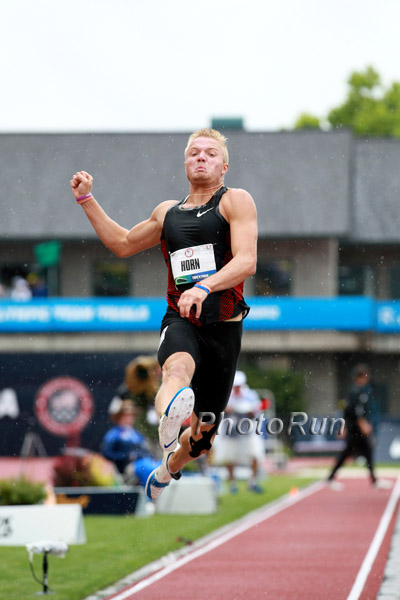The multi-events are full of drama, determination and pathos. The athletes who focus on the heptathlon, decathlon and pentathlon are a rare set. Physically gifted, mentally tough, huge work ethic, and the ability to look eight to ten years down the road are key characteristics of successful multi-eventers.
Gray Horn: Emerging Brother
February 21, 2014
Track & field is an extremely competitive sport. The rivalries are intense and the margin for error is slim. Such an athletic environment is not often conducive to friendly relationships among competitors. But the decathlon is different. Make no mistake, decathlon competitors  go after each other hammer and tong. But when the two-day 10-event war of attrition is over, and the final event – the 1500 meter run – is in the books, the fellowship of athletes bonds together for a sort of victory lap – the victor to celebrate a hard-fought win, some to celebrate personal bests, and many simply to display gratitude for having survived one of the most demanding athletic contests in sport.
go after each other hammer and tong. But when the two-day 10-event war of attrition is over, and the final event – the 1500 meter run – is in the books, the fellowship of athletes bonds together for a sort of victory lap – the victor to celebrate a hard-fought win, some to celebrate personal bests, and many simply to display gratitude for having survived one of the most demanding athletic contests in sport.
One of America’s blossoming 10-event competitors is Gray Horn. An Ohio native, Horn got hooked on track & field at an early age. When he was 10, Gray went to the track with his grandfather, a longstanding track & field coach. “He set up a high jump bar to see how I would do with it,” recalls Horn. “I just fell in love with it immediately and I have been doing it ever since.”
Early on, Horn developed his skills through the USATF youth programs. “Ever since I started, I did the entire USA Track & Field Junior Olympics series – all the way from the bantams up to the masters.” It served him well. Horn went on to capture multiple state titles – in such diverse events as the 110 hurdles, the pole vault, and the long jump.
The young multi-eventer moved on to a top-flight collegiate program at the University of Florida. Adaptation was required. “Starting out, it was kinda tough so far away from home. And then there was a coaching change my freshman year. I asked myself, ‘Do I try to go to another school? Or do I trust that Mike Holloway will hire the right multi coach for me’,” states Horn. “I ended up sticking around. I trusted the process. I knew we were going to end up winning an NCAA title and I wanted to be a part of that.”
Before long, the Ohio native began to get comfortable in Gainesville. “I had the chance to train with [Olympic Decathlon gold medalist] Brian Clay and Mike Morrison,” notes Horn. Before promising multi prospect Morrison transferred to Cal Berkeley, the two young decathletes developed an athletic friendship. “Mike Morrison was like a big brother figure to me when I first got to Florida. He has been a big part of my maturing process in the multi events.”
Under Florida coach Mike Holloway’s tutelage, Gray Horn continued to progress as a multi-event athlete. The steady strengthening of the entire Gator program – U of F missed the 2011 NCAA team title by a single point – also suggested that Horn’s goal to be part of a national championship team might also be realized. But that quest took an unfortunate turn during Horn’s senior year. “I was suspended during the 2012 outdoor season when Florida ultimately won the NCAA championship,” Horn explains.
The suspension caused Horn to miss valuable competition opportunities during an Olympic year. And it also denied the young athlete the opportunity to win his 4th consecutive SEC decathlon title. But the passage of time now allows the Horn to view that disciplining incident in proper perspective. “That was something that I think really needed to happen to me. I think it was kind of a wake up of call, knowing that I needed to develop a higher code of conduct. It was a really good growing up experience,” Horn confides. “In the long run, I think I am kind of glad that it happened.”
But that suspension had implications for Horn beyond the collegiate season. In late June of 2012, Horn captured third place in the U.S. Olympic Trials decathlon – a finish that would normally secure an Olympic team berth. Horn’s Olympic Trial placing was good, but his deca point total was insufficient. Horn’s OT point total of 7954 was short of the A standard total of 8200 required to go to London. “I think that missing the SEC and NCAA decathlons really took a hit on my chances to make the standard – especially since the weather was so awful during the trials,” reflects Horn.
Horn’s progression continues. His strength is in the explosive events – the long jump [7.70m / 25’3¼”], the 110 hurdles [14.16], the high jump [2.08m / 6’9¾”] and the pole vault [500m / 16′ 4¾”]. ‘Those skill events are my big point scorers, the events that really set me apart,” notes Horn.
Like all decathletes, Horn spends focused practice time on his weaker events – which for Horn are the Javelin and the 400 meters. “I was an all-state tight end. So throwing the football is a habit that is instilled. And throwing the football and throwing the javelin are two completely different things,” explains Horn. “So I had some really bad habits that I had to work out. But I’ve come along way,” he adds while noting that his Jav PR is now out to 56.85m [186’6″] with more improvement to come. While Horn’s 49.34 PR in the 400m lags behind most of his elite competitors, his one-lap mark is nonetheless impressive given Horn’s towering Tom Pappas-like physique.
Recently, Horn joined the coaching staff at Ashland University. Moving to the Div. II track & field powerhouse in central Ohio seems to make sense on several levels. “I made the move to Ashland for a couple of reasons. First of all, I came for the coaching position. I see my post-competition career in coaching. Secondly, I came here to train under [multiple time Olympian in the hammer throw] Jud Logan. I came here for his strength program and his throws,” Horn explains. “I think that you will see a really big improvement out of me in 2014. Practices are going well. I am feeling strong. I’m feeling better than I ever have. There are things that I can improve on and I am improving on them at this time.”
Without question, decathletes exude a rare and unique mutual respect and friendship not easily found among competitors in other events. What is it that somehow creates this special bond among track & field’s most diversely-talented gladiators? Horn thinks he knows. “In sprinting events, you see a lot of rivalries and some animosity which provides excitement for the sport,” the young decathlete explains. “But if you’re a multi-eventer and you have to spend two days in competition with somebody, you’re sharing more than just a competition. You are sharing your personal life, training ideas, stuff that you do. Stuff like that really connects all of us. What other event gets together when their event is completed and takes a picture?” asks Horn rhetorically. “That is a tradition that we have. After the 1500, we all get together, we put our arms around each other, and we take a picture for the memories sake. It is something that is very rare. It is like a fraternity.” And with a tinge reverence, Horn adds, “And I couldn’t be more proud to be involved with people who are called ‘the world’s greatest athletes.'”
Gray Horn’s multi performances to date have already granted him entry into the decathlon fraternity. But what is next? “My goal is to be an Olympian. That’s always been the goal since Day One,” Horn unabashedly reveals. “Whether or not I always thought that goal was a possibility is kind of up in the air. But I have never been as sure about it as I am now,” Horn offers candidly. 
; “If you would have told me as a kid that I would be where I am now, I would have said you were crazy.” But then the Ashland coach frankly admits, “Knowing everything that has happened so far is possible, I am going for broke now.”
And this weekend in New Mexico, Gray Horn will walk out onto that indoor track in the Albuquerque Convention Center not just to compete in the heptathlon, but also to connect with his fellow multi-sport warriors and to pursue the chance to elevate his standing in the Band of Brothers.
~Dave Hunter




















